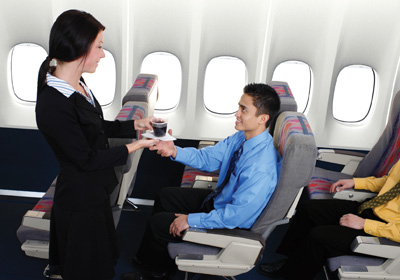
Features
Operations
Alternate Approach: Cash cabin (but don’t bring cash)
The airline industry is cashing in on the discretionary spending habits of travellers in the cabin.
November 3, 2010 By David Carr
The airline industry is cashing in on the discretionary spending habits of travellers in the cabin. Worldwide, revenue from a la carte features such as baggage fees, onboard food and commissions from travel-related services such as hotel rooms and car rentals jumped 43 per cent in 2009 to $13.5 billion, according to Amadeus, a supplier of transactional technologies such as point of sale (POS) handheld devices, and Idea Works, a consultancy specializing in airline ancillary revenues.

|
|
Toronto-based GuestLogix, the world’s largest supplier of onboard store technology claims the average passenger spends $24 in the cabin. Expect the size and scope of inflight retail to expand as airlines use the cabin to increase non-ticket revenue. It represents air transport’s second retail revolution following the airport industry’s aggressive push into shopping mall-style merchandising in the 1980s and 1990s, lead by the UK’s BAA plc.
Except the airlines are more likely to take a page out of the cruise ship industry, which relies heavily on ancillary revenue, Nelson Gentilleti, chief operator officer for Transat A.T. told Wings. Gentilleti believes that onboard retailing is the next evolution in air travel, including charging for premium content on inflight entertainment systems.
Doug Hesley, corporate director of revenue management for Norwegian Cruise Lines described ancillary revenue as an untapped well. “When an airline offers me priority boarding and a complimentary beverage in exchange for $10, you’ll see me paying $10 with a smile on my face – I value early boarding and safely storing my carry-on,” he said.
In September, WestJet followed Air Canada’s lead by switching to a cashless cabin. Handheld POS devices store inflight transaction data until the aircraft is on the ground. Both airlines have limited onboard transactions to credit card only, sealing off the potential of debit cards – neither is concerned. Approximately 85 per cent of Canadians carry credit cards and onboard vouchers are available at check-in.
Besides moving the liquor cart along the aisle faster by eliminating the frustration of passengers fumbling for change, airlines will no longer have to simplify price lists by charging in one dollar increments, potentially lowering the price for food and drink services, or at least slowing the rate of increase.
The real advantage can be found in a recent report into onboard retailing by GuestLogix in partnership with Airline Weekly, a Florida-based industry newsletter. Among the findings, airlines that accepted credit cards onboard generated higher revenue per passenger trip. JetBlue was one of the early pioneers of the cashless cabin in 2007, and watched its daily onboard revenues almost double in the first week.
According to the Amadeus report, Air Canada is already one of the world’s top 10 performers in ancillary revenues, collecting over $774 million in 2009, or just over $23 per passenger. United Airlines, Air Canada’s Star Alliance partner topped the list earning over $1.8 billion in ancillary revenue.
Interesting, none of the legacy carriers on the list including American Airlines, Delta, Qantas and US Airways crack the list of top ten airlines with ancillary revenue as a percentage of total revenue. That list is dominated by cost-cutters such as Allegiant (29.2%), Spirit (23.9%), Ryanair (22.2%) and Easyjet (19.4%).
As airlines struggle with the volatility of fixed costs such as fuel, the industry will place even more emphasis on ancillary revenues, matching products and services with what passengers put the greatest value on – which means that all offerings cannot be all things to all cabins, although GuestLogix estimates that airlines who sell comfort items such as blankets, pillows and inflight entertainment services will continue to be industry leaders in liberating passengers from their cash (or in this case, credit room).
In addition to core items such as food, beverage and passenger comfort amenities, travellers can expect expanded choice in duty free goods and destination-based products and services. The sky is the limit, but perhaps the industry could begin with its food offerings. Despite advances in web-based technology to build a better flight experience and legacy carriers still equipped to provide a hot meal service, menus remain remarkably mediocre and tough to swallow. Pre-ordering of hot, full-course meals in the economy cabin – that would be a retail revolution.
David Carr is a Wings writer and columnist.